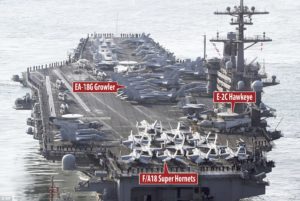by WorldTribune Staff, March 22, 2017
A massive U.S. show of force and South Korea’s deployment of the THAAD missile defense system in response to a perpetually belligerent North Korea are raising tensions – and preparations for war – on the Korean Peninsula.
The arrival of a U.S. aircraft carrier strike group is reportedly part of a Trump administration plan aimed at “incapacitating” North Korean leader Kim Jong-Un’s regime should conflict break out.

Pyongyang said the arrival of the USS Carl Vinson was part of a “reckless scheme” to attack it.
North Korea’s state KCNA news agency said: “If they infringe on the DPRK’s sovereignty and dignity even a bit, its army will launch merciless ultra-precision strikes from ground, air, sea and underwater.”
China, which has been highly critical of South Korea’s deployment of THAAD after enabling North Korea’s strategic weapons buildup, called on all sides to “end a vicious cycle that could spiral out of control.”
More than 80 aircraft, including F/A-18F Super Hornets, E-2C Hawkeyes and the carrier-based EA-18G Growler are on board the USS Carl Vinson and are taking part in wargames with South Korea.
A South Korean military official, who wished to remain anonymous, told Yonhap: “A bigger number of and more diverse U.S. special operation forces will take part in this year’s Foal Eagle and Key Resolve exercises to practice missions to infiltrate into the North, remove the North’s war command and demolition of its key military facilities.”
Rear Adm. James Kilby, commander of USS Carl Vinson Carrier Strike Group 1, said: “The importance of the exercise is to continue to build our alliance and our relationship and strengthen that working relationship between our ships.”
The U.S. has also begun to deploy Gray Eagle attack drones to South Korea, a military spokesman said.
A North Korean envoy told Reuters on March 21 that Pyongyang fully intends to continue to “strengthen our national defense capability.”
This includes developing a “pre-emptive first strike capability” and an inter-continental ballistic missile (ICBM), said Choe Myong Nam, deputy ambassador at the North Korean mission to the United Nations in Geneva.
Reuters, quoting a senior U.S. official in Washington, reported on Monday that the Trump administration is considering sweeping sanctions as part of a broad review of measures to counter North Korea’s nuclear and missile threat.
Choe called existing sanctions “heinous and inhumane.”
Asked to comment on Choe’s remarks, a U.S. State Department spokeswoman, Anna Richey-Allen, called on North Korea “to refrain from provocative actions and inflammatory rhetoric … and to make the strategic choice to fulfill its international obligations and commitments and return to serious talks.”
Meanwhile, a North Korean missile appeared to have exploded on March 22 just after it was launched, Reuters reported.
The launch attempt was made from near the city of Wonsan, on North Korea’s east coast, the same site from which were launched several intermediate-range missiles last year, all but one of which failed.
“U.S. Pacific Command detected what we assess was a failed North Korean missile launch attempt … in the vicinity of Kalma,” Commander Dave Benham, a spokesman for U.S. Pacific Command, said in a statement, referring to an air field in Wonsan.
“A missile appears to have exploded within seconds of launch,” Benham said, adding that work was being carried out on a more detailed assessment.
Also on March 22, the Chinese military issued a warning to a U.S. Air Force B-1 bomber flying in the East China Sea, two U.S. officials told Fox News.
The Chinese said the U.S. bomber was flying in international airspace. American officials told Fox News the bomber was flying in international airspace and continued on its mission without its wingman.
Fox News reported that two B-1 bombers were set to launch a patrol from Guam to the Korean Peninsula as part of training exercises with the South Koreans, hours after the failed North Korean missile launch.
Only one B-1 bomber was able to take off. The other was scrubbed due to maintenance issues.
The Chinese warning came over the emergency radio frequency known as “guard,” according to one official. The incident unfolded when the American bomber was flying 70 miles southwest of the South Korean island of Jeju, Fox News reported.
